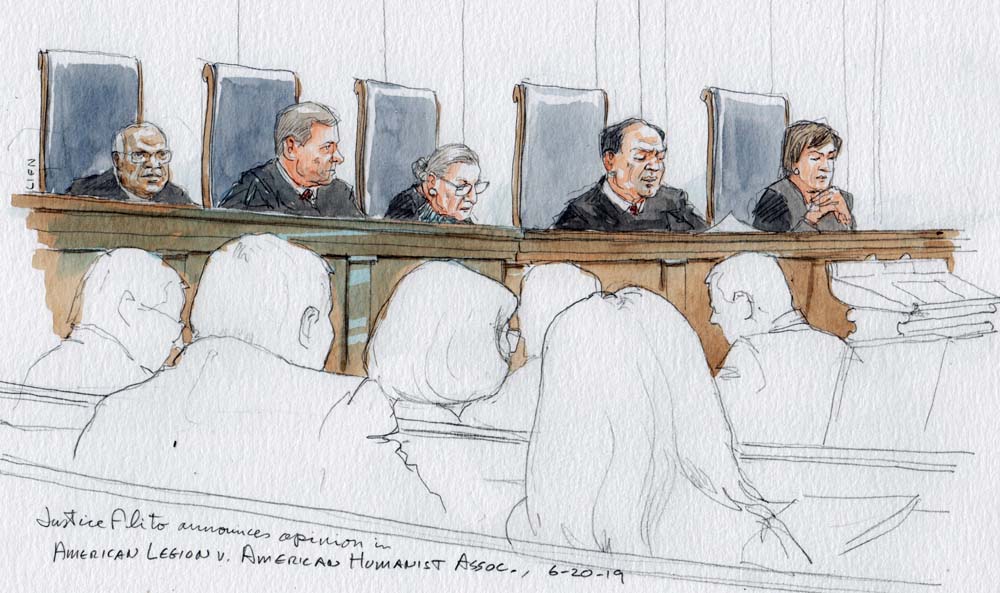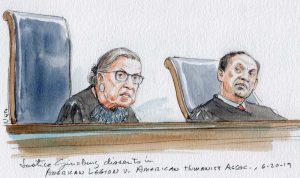A “view” from the courtroom: “Quite prolific in our writing”

on Jun 20, 2019 at 5:54 pm

Art Lien, SCOTUSblog’s talented sketch artist, commutes to the court from Baltimore, and a traffic jam on the Capital Beltway this morning sent him to Google Maps for an alternate route, which just happened to take him past the Bladensburg Peace Cross, the memorial at the center of the pending case of The American Legion v. American Humanist Association. Lien tweeted a quick photograph as he approached the traffic circle where the cross stands. (Lien reports that traffic was stopped when he snapped the photo, but his fellow drivers may still be thankful he didn’t take out his ever-present sketch pad.)
Perhaps it was fate, perhaps just a coincidence, but Lien and others in the courtroom will soon hear much more about the fate of the cross.
As is typical of the first extra day for opinions, the public gallery is full, but the bar section is nearly empty. Solicitor General Noel Francisco is here, after missing Monday’s session, along with five or six members of his staff. No more than 10 seats in the rest of the bar section are occupied, though one lawyer present today is Neal Katyal, the former acting U.S. solicitor general who argued the cross case in February on behalf of the Maryland-National Capital Park and Planning Commission, a petitioner along with The American Legion.
Perhaps it is fate, coincidence, or just a good spidey-sense on Katyal’s part that a decision in this case could come today. The cross case is not his only pending decision, and today will turn out to be a good one for Katyal.
The court takes the bench, and Justice Ruth Bader Ginsburg is wearing the black-jeweled jabot that she favors for reading dissents from the bench. We’ll have to wait a bit to learn why.
Chief Justice John Roberts says, “In case number 17-6086, Gundy versus United States, the court’s opinion will be announced by …”
Gundy was argued Oct. 2, and is the longest outstanding opinion, leading to much speculation that Justice Sonia Sotomayor was writing the opinion because she is the only one of the justices who has not written a majority opinion from the October sitting.
But the chief justice does not appear to be forming a word that begins with “s.” No, the decision “will be announced by Justice Kagan,” he says.
Kagan begins on a conversational note. “The opinion I’m going to describe is written for a plurality of the court—four justices from an eight-person court,” she says. “Another justice came to the same result in the case but didn’t sign on to any of the reasoning in the opinion.”
The case involves whether a provision of the Sex Offender Registration and Notification Act violates the “nondelegation doctrine,” which bars Congress from delegating its legislative powers to the other branches.
Kagan explains the heart of the issue, which involves the attorney general’s adopting a rule in 2007 that applied SORNA’s registration requirements for convicted sex offenders to “a group of people I’m going to call pre-act offenders,” she says.
Kagan says the “four of us” in her plurality believe the relevant provision requires the attorney general to apply SORNA’s registration requirements as soon as possible.
“And once the statute is understood that way, the four of us think the constitutional question becomes quite easy,” she says. “Although Congress can’t delegate its power to make laws, it can give executive agencies substantial discretion to implement and enforce the laws.”
She announces that Justice Samuel Alito is the fifth vote in the judgment, but she doesn’t attempt to characterize his short opinion. Justice Neil Gorsuch has filed a dissenting opinion, joined by the chief justice and Justice Clarence Thomas, she notes.
That adds up to eight, and she did note the case was heard by an eight-member court. But she does not mention from the bench that Justice Brett Kavanaugh, who had not yet been confirmed when the court heard arguments, took no part in the consideration or decision of the case.
Sotomayor is up next with the decision in McDonough v. Smith, a case about the statute of limitations for a fabricated-evidence claim brought by a county election commissioner in New York state. The facts of the case are messy, and the opinion is technical, but the court rules that a limitations period for the commissioner’s civil lawsuit against his accuser did not begin to run until the commissioner’s acquittal on criminal charges, and thus his civil case is revived.
Katyal argued the case on behalf of the petitioner, Edward McDonough, so he has notched a victory this morning.
The chief justice announces that Alito has the opinion in the Bladensburg cross case.
As we noted the other day, Alito tends to give very short summaries from the bench except in more momentous cases. This summary will not be short.
Alito describes how during World War I, the military marked the graves of fallen American soldiers in Europe with temporary wooden crosses or Stars of David, which was a departure from marking them with the uniform “rectangular slabs” seen in national cemeteries here at home.
The images of row after row of the crosses was moving to the public, he says, and when the War Department announced after the 1918 armistice that the wooden crosses and Stars of David would be replaced with the traditional slabs, there was an outcry.
He describes the history of the Bladensburg cross, which was meant to honor the World War I dead of Prince George’s County, Maryland. After a fundraising campaign and the intervention of a local American Legion post, the monument was finished in 1925, listing the names of 49 local men, both black and white, who died in the war.
He quickly summarizes how the state agency, the Maryland-National Capital Park and Planning Commission, acquired the cross and the land on which it sits, to help preserve it and to address traffic safety concerns around its busy site.
Alito, in summarizing the procedural history of the establishment clause challenge brought by the American Humanist Association, seems to relish highlighting a possible remedy discussed by the U.S. Court of Appeals for the 4th Circuit, which ruled against the cross and mentioned the suggestion of the challengers that the arms could be removed to form a non-religious slab or obelisk. As Alito puts it, the remedies included removal or demolition of the memorial, “or at least that the arms be amputated.”
He explains what is not a surprise by this point, that the 4th Circuit ruling against the court is now reversed, based largely on the role of the cross in World War I and the longstanding nature of the monument. Katyal has his second win of the day.
“The fallen soldiers’ final resting places abroad were marked by white crosses or Stars of David,” Alito says. “The solemn image of endless rows of white crosses became inextricably linked with and symbolic of the ultimate price paid by 116,000 soldiers. And this relationship between the cross and the war undoubtedly influenced the design of the many war memorials that sprang up across the nation.”
He concludes on an eloquent note.
“For some, [the] monument is a symbolic resting place for ancestors who never returned home,” Alito says. “For others, it is a place for the community to gather and honor all veterans and their sacrifices for our nation. For others still, it is a historical landmark. For many of these people, destroying or defacing the cross that has stood undisturbed for nearly a century would not be neutral and would not further the ideals of respect and tolerance embodied in the First Amendment.”
Before he announces the lineup, he notes that “my colleagues and I have been quite prolific in our writing.” There are concurring opinions from Justices Stephen Breyer, Kavanaugh, and Kagan, and opinions concurring in the judgment by Thomas and Gorsuch (with various cross-signings). Ginsburg has filed a dissent, joined by Sotomayor.
The lineup reminds me of a time when Justice Sandra Day O’Connor announced a similarly complex listing and quipped that there appeared to be “more opinions that there are justices.”
Alito turns to his right, and Ginsburg speaks up.
“This case, as you have just heard, concerns an immense Latin cross standing alone on a traffic island at the center of a busy three-way intersection in Bladensburg, Maryland,” she says.
Ginsburg’s voice, weakened by a cold and laryngitis on Monday, is considerably stronger this morning, if not quite 100 percent. Perhaps she got a boost from winning the MTV Movie & TV Award as “best real-life hero” in a show that aired on Monday night.
“The Latin cross is the foremost symbol of the Christian faith,” she says. “The Latin cross is not emblematic of any other faith. By maintaining the Peace Cross on a public highway, the state places Christianity above other faiths and conveys a message of exclusion to non-Christians, nearly thirty percent of the U.S. population, telling them they are outsiders, not full members of the political community.”
She goes on for several more minutes before concluding with, “Justice Sotomayor joins me in this dissent.”
This might seem like a good bit of drama on which to end the day’s opinions. But there is one more decision, and it is decidedly less profound. Breyer has the opinion in PDR Network LLC v. Carlton & Harris Chiropractic Inc., about whether the Hobbs Act requires a federal district court in this case to accept the Federal Communication Commission’s interpretation of the Telephone Consumer Protection Act, which prohibits any “telephone facsimile machine” from sending an unsolicited advertisement to another fax machine.
“The case is more difficult than my summary makes it sound,” says Breyer, whose brief summary so far hasn’t made it sound particularly easy.
He quickly adds that “we’re sending it back.” While there is not a great deal the court agrees on in multiple opinions, it is remanding the case to the 4th Circuit to consider two preliminary questions arising from an order of the Federal Communications Commission.
He pauses and almost forgets to announce the lineup. “Oh, wait,” he says, noting that while there is a majority for the limited resolution, Thomas has filed an opinion concurring in the judgment, joined by Gorsuch, while Kavanaugh has filed an opinion concurring in the judgment, joined by Thomas, Alito and Gorsuch.
As the justices rise to leave the bench, Marshal Pamela Talkin announces that we will do this all again on Friday.
The question is, what fateful or coincidental route might Google Maps recommend for Art Lien tomorrow? Through Maryland’s sixth congressional district, at the heart of political gerrymandering case Benisek v. Lamone? Past the Suitland, Md., headquarters of the U.S. Census Bureau, central to the citizenship-question case of Department of Commerce v. New York? Or maybe just his normal route.





